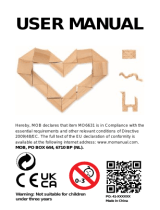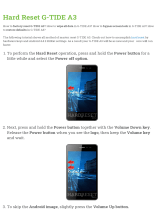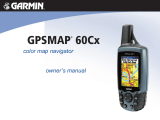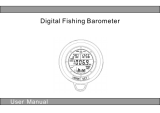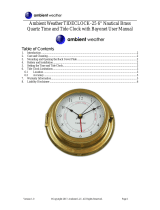
Table of Contents
Introduction.....................................................................1
Device Overview......................................................................... 1
Keys............................................................................................ 1
Main Pages............................................................................ 1
Viewing the Main Menu..........................................................1
Battery Information..................................................................... 1
Maximizing Battery Life.......................................................... 1
Turning On Battery Save Mode............................................. 1
Long-Term Storage................................................................ 1
Installing AA Batteries............................................................ 1
Installing the Battery Pack..................................................... 2
Turning On the Device................................................................ 2
Adjusting the Backlight Brightness and Volume......................... 2
Product Updates......................................................................... 2
Setting Up Garmin Express................................................... 2
Connected Features....................................................... 2
Connected Feature Requirements............................................. 2
Setting Up Wi‑Fi Connectivity..................................................... 3
Connecting to a Wireless Network......................................... 3
Pairing a Smartphone with Your Device..................................... 3
Phone Notifications..................................................................... 3
Viewing Phone Notifications.................................................. 3
Hiding Notifications................................................................ 3
GPS Satellite Signals..................................................... 3
Acquiring Satellite Signals.......................................................... 3
Changing the Satellite View........................................................ 3
Turning Off GPS......................................................................... 3
Simulating a Location................................................................. 3
Simulating a Route..................................................................... 3
Enabling GLONASS and WAAS................................................. 4
Waypoints, Routes, and Tracks.................................... 4
Waypoints................................................................................... 4
Creating a Waypoint.............................................................. 4
Finding a Waypoint................................................................ 4
Project a Waypoint................................................................. 4
Navigating to a Waypoint....................................................... 4
Increasing the Accuracy of a Waypoint Location................... 4
Editing a Waypoint................................................................. 4
Editing a Category................................................................. 4
Deleting a Waypoint............................................................... 4
Routes........................................................................................ 4
Creating a Route.................................................................... 4
Activating a Route.................................................................. 4
Copying a Route.................................................................... 4
Editing the Name of a Route.................................................. 4
Editing a Route...................................................................... 5
Deleting a Route.................................................................... 5
Navigating a Saved Route..................................................... 5
Viewing the Active Route....................................................... 5
Stopping Navigation............................................................... 5
Reversing a Route................................................................. 5
Taking a Detour..................................................................... 5
Planning Your Route.............................................................. 5
Tracks......................................................................................... 5
Recording a Track..................................................................5
Viewing the Active Track........................................................5
Saving the Active Track......................................................... 5
Clearing the Active Track....................................................... 5
Deleting a Track..................................................................... 5
Navigating a Saved Track...................................................... 5
Archived Tracks..................................................................... 5
Sending Data Wirelessly.............................................................6
Receiving Data Wirelessly.......................................................... 6
Navigation....................................................................... 6
Find Menu................................................................................... 6
Navigating to a Destination......................................................... 6
Stopping Navigation....................................................................6
Finding a Location by Name....................................................... 6
Finding a Location Near Another Location................................. 6
Navigating with the Compass..................................................... 6
Calibrating the Compass........................................................6
Course Pointer....................................................................... 6
Navigating with the Map............................................................. 7
Navigating Using TracBack®...................................................... 7
Avoiding Road Features............................................................. 7
Marking and Starting Navigation to a Man Overboard
Location...................................................................................... 7
Elevation Plot.............................................................................. 7
Navigating to a Point on the Elevation Plot............................ 7
Changing the Plot Type......................................................... 7
Calibrating the Barometric Altimeter...................................... 7
Trip Computer............................................................................. 7
Resetting the Trip Computer.................................................. 7
Highway Page.............................................................................7
BirdsEye Imagery........................................................... 7
Calendars and Weather Data......................................... 7
Viewing the Calendar..................................................................7
Viewing Tide Information............................................................ 7
Viewing Celestial Data and Almanacs........................................ 8
Viewing Current Weather Conditions and Forecasts.................. 8
Customizing the Device................................................. 8
Customizing the Data Fields....................................................... 8
Customizing the Page Layout..................................................... 8
Configuring the Maps..................................................................8
Map Setup.................................................................................. 8
General Map Settings............................................................ 8
Map Settings.......................................................................... 8
Marine Settings...................................................................... 9
Marine Navigation Settings.................................................... 9
Compass Settings.......................................................................9
Trip Computer Settings............................................................... 9
Highway Page Settings...............................................................9
Alarms Settings...........................................................................9
GPS Satellite Settings................................................................ 9
System Settings.......................................................................... 9
Serial Interface Settings....................................................... 10
Display Settings........................................................................ 10
Routing Settings....................................................................... 10
Tracks Settings......................................................................... 10
Altimeter Settings......................................................................10
Sound Settings......................................................................... 10
ANT+ Sensor Settings.............................................................. 10
Timer Settings...........................................................................11
Time Settings............................................................................ 11
Changing the Units of Measure................................................ 11
Location Settings...................................................................... 11
Restoring All Default Settings................................................... 11
Device Information....................................................... 11
Device Care.............................................................................. 11
Cleaning the Device............................................................. 11
Optional Fitness Accessories................................................... 11
Pairing Your ANT+ Sensors................................................. 11
Tips for Pairing ANT+ Accessories with Your Garmin
Device.................................................................................. 11
Data Management.................................................................... 11
File Types............................................................................ 11
Installing a Memory Card..................................................... 12
Connecting the Device to Your Computer........................... 12
Table of Contents i


















